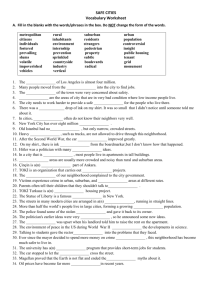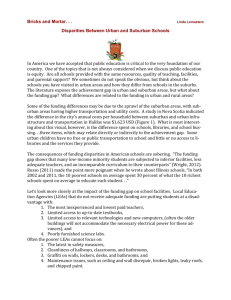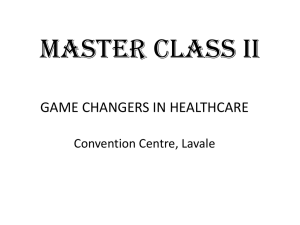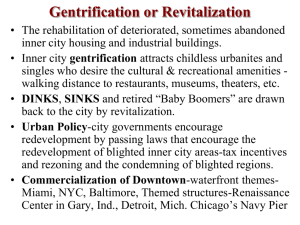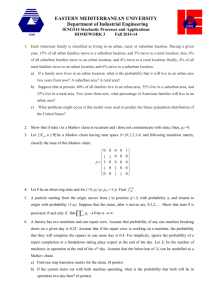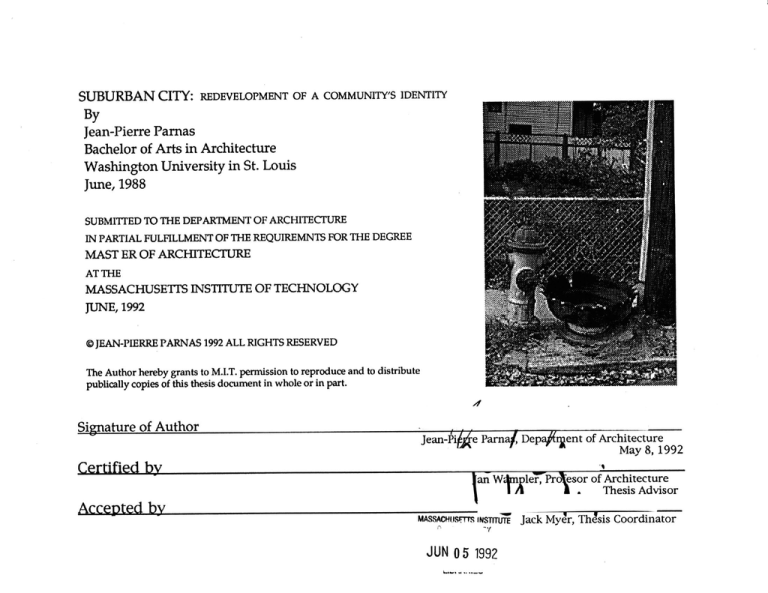
SUBURBAN CITY:
REDEVELOPMENT OF A COMMUNITY'S IDENTITY
By
Jean-Pierre Parnas
Bachelor of Arts in Architecture
Washington University in St. Louis
June, 1988
SUBMITTED TO THE DEPARTMENT OF ARCHITECTURE
IN PARTIAL FULFILLMENT OF THE REQUIREMNT'S FOR THE DEGREE
MAST ER OF ARCHITECTURE
AT THE
MASSACHUSETTS INSTITUTE OF TECHNOLOGY
JUNE, 1992
@JEAN-PIERRE PARNAS 1992 ALL RIGHTS RESERVED
The Author hereby grants to M.I.T. permission to reproduce and to distribute
publically copies of this thesis document in whole or in part.
Sigature of Author
Jean-Pi
e Parna , Depa tent
by
May 8, 1992
1
Certified by
Accepted
of Architecture
le , Po
anW
-_,
MASSAC14Jsms msTmur
Jy
JUN 05 1992
k_* . . .. -_
R&CIF
esor of Architecture
a.
Thesis Advisor
Jack Myer, Thesis Coordinator
MITLibraries
Document Services
77 Massachusetts Avenue
Cambridge, MA 02139
Ph: 617.253.2800
Email: docs@mit.edu
http://Iibraries.mit.edu/docs
DISCLAIMER OF QUALITY
Due to the condition of the original material, there are unavoidable
flaws in this reproduction. We have made every effort possible to
provide you with the best copy available. If you are dissatisfied with
this product and find it unusable, please contact Document Services as
soon as possible.
Thank you.
The images contained in this document are of
the best quality available.
ACKNOWLEDGEMENTS
Special thanks to Marnie, my office mate.
Thanks to:
Jan Wampler for his support.
Lois Craig for the great resources.
Rene Chow for her sound advice.
Zsuzsanna for her enthusiasm and great help.
Jeffery Wheeler of the Somerville Planning Board for his
input and interest.
My parents for all their support.
To the Somerville Gang for their moral support
Jim Axley for putting up with my struggle and
confusion.
and especially to Helen for putting up with everything
and keeping me on my toes.
TABLE OF CONTENTS
A BSTR ACT ............................................................................................
i
FO REW ORD .........................................................................................
ii
INTRODUCTION.............................................................................
1) the House ..................................................................
2) the Culture ................................................................
3) the Community ........................................................
1
2
4
8
CONCLUSION..................................................................................12
SjnP D M~ UA NAOVWWT
%C0TW
IMPLICATIONS FOR DESIGN..........................................................13
ooK
416
...........................................................................................
M
%JuOEM A
R? I E
TO RIF IA O-f$.s
SITE
PEOPLE UMi ITIFMIM~S
M~
21
REFERENCES..................................................................................
22
1) Architectural...................................................................
2) Programmatic, Organizational.................................24
26
3) Contextual...................................................................
PROJE CT ................................................................................................
29
1) Urban Scale .....................................................................
30
2) Neighborhood Scale ......................................................
32
49
FUTURE IMPLICATIONS.............................................................
1) Land Use and Development.....................................50
2) Housing Types ...........................................................
PHOTOGRAPHIC CREDITS.........................................................
BIBLIOGRAPHY ..........................................................
51
52
54
i-
P
f
O_
5EWOO5TOG-,1"20 M
w o
I It A w
Ps
3MVV
ABSTRACT
SUBURBAN CITY:
By
Jean-Pierre Parnas
Redevelopment of a Community's Identity
Submitted to the Department of Architecture on May 8,1992
in partial fulfillment of the requirements for the Degree of
Master of Architecture
The thesis is a proposal for a community center and
residences in Somerville which takes into account three
aspects of American residential culture: 1) the changing
structure of the traditional family; 2) the changing suburb
and the competition with traditional center cities; and 3)
the loss of community identity that is a consequence of
the first two.
The project takes as reference research into the culture of
the American neighborhood, suburban or urban, as well
as various architectural, programmatic and contextual
examples.
Thesis Advisor: Jan Wampler
Title: Professor of Architecture
SUBURBAN CITY
FOREWORD
Suburban: Any relatively dense residential area that is
not urban.
Urban: Any dense residential area that is not suburban.
City: Any combination of the above two terms which
forms a conglomeration of residences and the activities
which support it.
The differences between the terms urban and suburban
have historicallybeen quite large. For nearly as long as they
have been needed to explain their differences, the two terms
have swung between extremely strong negative and positive
connotations , depending on the politicaland economic
conditions. Today, however, the differences are much less
apparent.There are many of the same social, financial,
political, and traffic problems in both environments. Both
seem to have the same degree of benefits and drawbacksfor
families. And, as suburbs are attractingmore businesses,
both support a similaramount of culture.
The result is that both terms have taken on a degree of
ambiguity which is reflected in the culture through
perceptionsof both environments: some say suburbs are
unhealthy and some say that urban areasare unhealthy. The
term city in this case is now a better definer because in can be
used for both suburbs and urban areas. Suburbs today are
much more like urban areas than they were at the turn of the
century. Therefore the title Suburban City refers to the
suburb as a city in the sense that it is beginning to--or should
start to-have the same diversity of people, variety of places
and neighborhoodsand identifiablephysical structure as
urban cities have.
111
INTRODUCTION
INTRODUCTION
The ideas surrounding the complex of America's
residential culture can be broken into three parts. 1)The
detached (often single-family) house is seen as a bastion
for the nuclear family and for the strength of the family
in society. 2) The arrangement of detached houses and
the attitudes which both support and are supported by
it constitute a complex cultural system which promotes
the establishment and control of private property. 3) The
neighborhood of the collection of houses constitutes a
community which is based on the individual and the
individual family and promotes the autonomy of the
individual.
-F
5
SUBURBAN CITY
SUBURBAN CITY
INTRODUCTION
1) the House
A house constitutes a body of images that give mankind proofs
or illusions of stability. ...The house shelters daydreaming,
the house protects the dreamer, the house allows one to dream
in peace.
- Gaston Bachelard, The Poetics of Space
...Houses must be special places within places, separatelythe
center of the world for their inhabitants,yet carefully related
to the largerplace...
-Charles Moore, et al, The Place of Houses.
At home, in the bosom of the familiarmeanings, we areat our
freest, out of the public view, spontaneousand unguarded,
tending to one another's upsets and replenishingeach other's
equilibriumfor ambiguities ... Strangersare kept out...
-Constance Perin, Belonging in America
The house is the symbol for the strength of the family in
American culture today; the family that is self sufficient
and independent. For Gaston Bachelard the House is a
place where daydreams occur and where childhood
memories are re experienced. The outside world is
dosed off and the interior becomes serenity and
intimacy: ...as a shelter, it is fortifying. (Bachelard). This
is the place where the family is in control of outside
influences; where the family's social rules are in place.
Charles Moore, et al also promote the house as a world
unto itself and suggest a very personal connection
between the house and its inhabitant that remains on an
emotional and intuitive level. This connection is
intended to give insight into the designing of houses for
both the designer and the inhabitant. Moore does make
reference to the ...community that surroundsyou , but this
is clearly subordinate to the desires of the owner of the
house; the house is ... the inhabitantsdreams made
manifest. Both Moore and Bachelard define the house as
deriving out of the inhabitants dreams. But what are
these dreams and from where are they derived?
IN TRODUCTION
SUBURBAN CITY
SUBURBAN CITY
INTRODUCTION
2) the Culture
.today's popular culture.. .dwells on passion, willfulness
and the trappingsof individualityrather than on the common
principles and ideas which bind us together and form our
culture. Today's suburbs seem to be a manifestation of the
extension of that ideology into the physical environment.
S.
-Thomas M. Colbert, Beauty and the Beast
'I think living alone is something everyone strives for at some
point. ...In a way you need to prove to yourself you can do it
on your own, that you don't need a roommate, ...a boyfriend
or a husband. That you can.. .manage... your household and
have it run just fine. Its a greatfeeling"'
Author: ....In the United States in 1990, almost 23 million
people lived alone, a 26 percent increasesince 1980.
-Laura White, from: "Home Alone" by Wendy Kalleen
In pre-industrialsocieties the two institutions which
sustained intimate contacts between adults were the extended
family and the local neighborhoodcommunity...But...the
modern nuclearfamily [now]only contains two adults.
...Furthermore,one third [now one-halflof all households
in urban areas, contain only one adult
Christopher Alexander, The Ciy
1966
INTRODUCTION
Residential suburban culture in America today is
dominated by concerns for the individual, the private
owner. Ownership is above all the symbol of success
and the house is clearly the symbol of ownership. The
single-family, detached house which dominates the
housing industry is itself dominated by the need to
market to the individual and has no incentive to support
community. The importance of privacy for families as
an amenity has become so important that the common
ground which constituted the traditional community is
disappearing: Common use and common ownership violate
the ideal of PrivateProperty...(Perin)
0X*4
13
SUBURBAN CITY
SUBURBAN CIY
INTRODUCTION
This reflects on the attitude society has towards
individuals. Christopher Alexander in 1966 explained of
the fundamental need for intimate human contact which
can only be achieved through daily, casual meeting
among the same people. Alexander goes on to express
concern that as residential areas become more and more
dense and as daily life realizes more choices and a faster
pace, the number of people one is in contact with on a
daily basis increases. Subsequently, the quality of those
meetings decreases. This, according to Alexander,
causes alienation and a tendency towards isolationism.
However, there is also a fundamental need for the
expression of individuality which becomes stronger as
the opportunity for intimate contact, and therefore
community, decreases. This need is manifested through
the detached house and its included privacy and
protection. Thus as people come to feel more alienated
they tend to need to express their individuality even
more strongly, which in turn leads to more emotional
distance between people.
IKULIULIIUN
'p~J TKL)UUUT1UN
The American family appears to be trying to hold on to
this dream of independence even though the structure
of the family is breaking down. Apparently one half of
all family households are headed by a single parent and
as stated above, the percentage of people living alone is
increasing dramatically. Despite these facts there is a
general reluctance to admit to the need for
interdependence among families and
individuals.... individualism is very different from healthy
democraticrespectfor ... individuals rights. It is the
pathologicalover-belief in the self sufficiency and
independence of the individual and the individualfamily, and
a refusal to permit dependence of any emotional weight to
form.(Alexander). The housing industry has not
addressed these issues: Subdivisions are designed and
built as they were thirty or forty years ago. Families
have very little choice but to live in isolation of each
other and must find ways outside of the system to
develop interdependent living conditions: There are
now more than ever in the U.S. cooperative residences
and linked public-private projects being built.
~UDU1WA1N ~L1 I
Z)UDVU ADAIN %-.A
SUBURBAN CITY
INTRODUCTION
3) the Community
...autonomy and withdrawal, the pathological belief in
individualfamilies as self-sufficient units, can be seen most
vividly in the physical pattern of suburban tract development.
... The houses stand alone: a collection of isolated,
disconnected islands. There is no communal land, and no
sign of any functional connection between different houses.
Christopher Alexander, The City as a Mechanism for
Sustaining Human Contact, 1966
16
The chief symbol of privacy and guarantorof each family's
claim to it is an unblemished lawn...
-Perin, Constance Belonging In America
[There is].. .a very large investment among everyone in the
community to basically pretend...problems don't exist... [The
residents] believe they are buying protectionfrom the kind of
problems they all know exist in the city.
-Jon Dunn, Exec. Dir. of Newton Multiservice Center
from: "Suburban Strife: Family Problems Surface in
Affluent Settings" by Boston Globe staff
17
Americans are likely to flee.. .ambiguitiesby not knowing
their neighborsat all.
-Perin, Constance Belonging In America
INTRODUCTION
Suburbs have come to a point in their development, at
which they are now beginning to compete with the
traditional urban, center cities for economic and cultural
identities. As both businesses and residents move from
cities to suburbs, the suburbs are forced to take on a
larger cultural burden than they were originally
intended to have. The inherency of relatively large lot
sizes in suburbs works against the possibility of
accommodating this burden through small-scaled, but
dense centers, and results in homogeneous land use.
fil20
SUBURBAN CITY
SUBURBAN CITY
INTRODUCTION
These factors and the greater efficiency of travel
afforded by the car have produced centers--Mallswhich do not relate themselves to the residential
structure of surrounding neighborhoods and can not
accommodate any cultural needs. Malls, because of
their strong connection to the car, serve far too many
people to constitute what one might identify as a
community; They are, in fact'too public. As
commercial and cultural (ie cinemas) centers become
more centralized, as the Mall is, trips to these centers
become less frequent and therefore must be more
efficient. With this comes a loss of regularity with
which people need to establish relationships with others
in a community. This new community breaks down all
forms of interaction between fellow residents and forces
people to withdraw and protect themselves from the
inhospitable environment of traffic and
strangers:.. .Today's men and women suffer from a continual
2
10
onslaught of information and sensations,a constant violation
of their sense of identity. (Branzi)
INTRODUCTION
SUBURBAN CITY
It can be concluded that the loss of community in
modem life has negative effects on American culture.
The change in the fundamentals of the family may or
may not be caused by this loss of community, but the
modem community does not in either case support this
change. Social rules inhibit people from reaching out to
strangers, but it may not be this attitude which is
detrimental, rather the fact that there are so many more
strangers in peoples lives and not enough dose
relationships. These rules are a holdback from when
strangers were strangers to a community, not to an
individual. For the culture is now one of individuals.
11
SUBURBAN CITY
INTRODUCTION
CONCLUSION
24
12
Taking Alexander's view, these problems are a result of
widespread densification and erode the individual's
sense of being part of a group. However, the traditional
community was based on densification to a degree. So
there seems to be an inherent conflict between future
development and society's needs for community. New
development needs to promote greater density but must
be sensitive to the local community and must in some
way strengthen it.
The position taken for this project is that the suburbs
have a potential for community which can be realized
by enhancing the existing identity through densification
and centralization to a degree. The amount of
densification and centralization is crucial to the life of
the project. There must be a balance between
densification-ie residential--and community--ie public
use; In too many instances high density residences are
developed without making an investment in the identity
of such a large community. The assumption then is that
an investment to better the community, while not
necessarily financially profitable, is worthwhile from a
social point of view.
INTRODUCTION
SUBURBAN CITY
IMPLICATIONS FOR DESIGN
The implications for the project fall into three categories:
1) The changing structure of the family and its
relationship to the single-family house.
2) The growing need for interdependence between
families or individual members of a community.
3) The need for identifiable centers on the local scale
within the environment of undifferentiated growth and
A~lA
densification.
1) The changed family structure indicates for housing, a
flexibility both in the design of the house and in the
attitudes of the residents to allow a mix of family typesf
within one neighborhood. The house for a typical family
must now accommodate the equal possibility of one or
two parents with children or a childless couple. Two
approaches seem to be obvious: A) Design housing
which is as flexible as possible to take into account the
different family types and B) Specify the housing so that
there is a range of housing types, each matching a
specific family type. The attitude taken for the project is
that both of these are too extreme and unrealistic. The
design of a house can never be flexible enough to
accommodate every family's specific needs and for it to
be so flexible all variety and interest would be
.
W
abolished.
13
INTRODUCTION
SUBURBAN CIrY
I
7g149-Detady
14
T
RE
I
T
of a Rarogecourt and hoa gardencourts.
27
The other alternative assumes so much specialization
that the house would hardly be able to be used by any
other family except by the original inhabitant. The units
must have a certain flexibility inherent in their design,
but that there are certain household types which require
specialization in the design of the unit. These
households might include: single parent; two or more
unrelated people; cooperative households (ie more than
one family or group of single residents); etc.
2) The fact that the family structure is not as strong as it
has been in the past--in other words, that the family can
no longer consider itself completely self sufficient-indicates that there is a need for more interdependence
among members in a community. The certain
indications of this need are seen in the proliferation of
support groups which have taken over the role of the
traditional community. The physical manifestation of
community-based social support is densification on a
local scale and mixing residential uses with leisure and
daily uses such as exercise and local grocery stores,
laundry-mats, etc. The residents have the opportunity to
interact on a casual and daily basis and to break barriers
imposed by the need to have easy access to the car.
INTRODUCTION
3) Suburbs have been developed with little hierarchy of
public and private, pedestrian and vehicular. Within
this environment, there is nothing within a certain
group of houses or neighborhoods, which gives it
identity and allows the residents a place where they can
meet as members of a community. The project must
take into account the neighborhood scale of planning
and must address the potential for an identifiable center
within a neighborhood. Because of the local nature of a
center it is important to promote the pedestrian use of it
through strong connections to the neighborhood.
Clearly a project for a neighborhood center must rely
strongly on its site for reference towards the design; one
of the most important aspects of the design must be in
discovering the character of the site and the
neighborhood.
SUBURBAN CITY
28
15
SUBURBAN CITY
SITE
SITE
The site of 309 Beacon street, Somerville is an L-shaped
lot with a relatively large frontage on a major street
connecting Somerville and Cambridge. This street has a
fairly strong line of two and three-family houses in a
pattern typical, although slightly less dense, of most of
Somerville. This line alternates in a pulsing pattern
between houses and commercial use buildings,
including, several blocks away, a large Star Market
supermarket. There is a small street along the side of the
lot, which presents some smaller-scale houses within a
seemingly closely-knit neighborhood. Directly adjacent
on the east edge is a light industrial building which
houses a small cabinet making shop and other small
wood working shops.
16
SITE
SITE
SUISURL$AN LIlY
SUBURBAN CITIY
The north side of the lot fronts along the commuter rail
tracks, which run from downtown to the north-western
suburbs. Across the tracks is Wilson square. Wilson
Square is really only the triangular intersection of
Somerville avenue and Elm street and includes a
Christy's 24-hour convenience store and gas station; a
Lechmere car wash with both self-serve and automatic
car wash services; a laundry-mat; and one or two nondescript stores. The car wash clearly dominates the siteside of the square and faces directly towards the site
across the rail tracks.
'!4~
\\.0
~
iii
KY
------
-
---
- --
S$WONJ 'TREET
Now
-
_
__________
U
17
up
SUBURBAN CITY
SITE
The site chosen in Somerville is applicable to address the
above implications because it exhibits the potential for
diversity and coherence which is part of the definition of
a community and at the same time has experienced the
overgrowth exemplified by the typical suburban
subdivisions. Somerville consists in fact of many local
centers which hold a potential for strengthening the
identity of their surrounding neighborhoods. Once again,
however, overgrowth has forced many of these centers
either to accommodate the increase of people or become
swamped under it. The consequence of this progression
is that centers are becoming larger. They need to serve
more people, and therefore are becoming overcentralized.
These larger centers serve the practical needs of residents
very efficiently, but do not support the need for local
contact and community. The proposal for a community
center and residences projects a center at a scale smaller
than that of the commercial center and of a different
focus. The project addresses the missing local contact by
including uses which promote daily activity.
18
SITE
bUDIUKDAON k-11 I
19
REFERENCES
SUBURBAN CITY
REFERENCES
References were gathered in three categories, each
having different impacts on the project:
1) Architectural. Existing or proposed projects which
had a dear intention towards developing a community,
were used to gain a formal and symbolic understanding
of community.
2) Programmatic. These were used to gather specific
information for the program of the project.
3) Contextual. The site had a great influence on the
project through the existing housing types and the
density of the spaces.
21
SUBURBAN CITY
1) Architectural
REFERENCES
Figures 33 and 34 show a community center project in
Norway, which describes a significant public open space.
The space is connected to the street through the complex
itself and defines the street at a pedestrian scale.
30
33
22
22
.
. --
-
-*
--
344
RE FERENCES
Architectural references
SUBURBAN CITY
Figure 35 is project for a large athletic and civic center in
Texas. The significance of the public open space is
apparent in the planning (see p25 fig 43) and is
symbolically supported by the arcade which runs
around it. The tower, which holds the court house, in
this case serves as a civic symbol and amplifies the
public space.
Figures 36 and 37 are two apposing projects, one (fig 36)
is a community center in Germany which incorporates
housing; the other is a housing project in Vienna which
relies on the housing itself to support community.
36
..... ....
35
..
37
23
SUBURBAN CITY
REFERENCES
2) Programmatic, Organizational
The diagrams in figures 38 -40 describe how three
projects define exterior space through the arrangement of
their pieces.
Figure 41 shows a community center in New York which
supports the idea of a pedestrian way through the
complex but within the city.
38
39
24
40
41
REFERENCES
REFERENCES
Programmatic references
SUBURBAN CITY
SUBURBAN CITY
Figures 42 and 43 are the plans for the projects in figures
33 (p22) and 35 (p23) respectively. Figure 42 is
organized around the open space connecting to the
street, at the west (down) through a formal
attitude towards the street. The public space is open
towards the main street to the south (at the right) in the
plan.
Figure 44 shows an example of one of the possible uses
within a community center.
125
42
25
SUBURBAN CITY
REFERENCES
3) Contextual
45
26
Figures 45-47 diagram and illustrate the typical housing
type in Somerville. The density of building creates a
micro-range of public to private outdoor spaces and
forces the limited space to carry the large burden of
privacy. The primacy of the symbol of house is very
strong despite the density. Figure 48 illustrates the power
of the house symbol.
Contextual references
There are also a number of instances of especially newer
housing which subordinate the house symbol to the
image of collective and to the livelihood of the street.
The non-residential aspects of the area of the site offer
two levels of reference.
The industrial vocabulary is a strong part of Somerville
and is often mixed bluntly with the residential. There is
also an opportunity to both accept the strong presence
and to use it as a unifier. Especially in this case, the train
tracks cut through a neighborhood and the potential to
connect the two sides is strong and can be strengthened
even more by giving that connection definition through
the train's vocabulary: The negative image of the train
can be used to identify the positive connection.
REFERENCES
SUBURBAN CITY
5
512
27
PROJECT
PROJECT
PROJECT
SUBURBAN CITY
SUBURBAN CITY
The project consists of a pedestrian path which both
connects two parts of a neighborhood and brings those
parts together in a local center which, along with the
activity of included residences, promotes the identity of
the community. The community in this case is defined
by a walking distance radius, thus creating an
environment inductive to personal contact rather than
the impersonal environment created by the automobile.
The main focus of the project is the path running
between two major streets and the activity on it. Two
types of activity are promoted. Through pedestrian
traffic, including commuters walking to the subway and
bus stations and the daily activity of both immediate
residents and those living on the immediate periphery
of the site. The daily activity of local residents is
supported by both specific needs--ie convenience store,
cafd, laundry-mat-and more general, cultural usesswimming pool, athletics rooms, day care, library,
meeting hall.
The housing reflects both the existing diversity of family
types and the general trend of the changing family
structure. Thus there are four types of units included in
the twelve total units.
29
SUBURBAN CITY
PROJECT
1) Urban Scale
3
30
The entrances to the path at each of the main streets is an
important part of the existing physical character. On the
Beacon Street side (south) a residential character
predominates and the project reflects that by stepping
down towards the street and creating an entrance which
continues the strong street frontage and at the same time
remains public. The character of the Somerville side is
more industrial and less removed from the car
(See also pages 44-45)
SUBURBAN CITY
PROJECT
SUBURBAN CITY
PROJECT
Site Plan
II I;p-
_
0
_
_
akI Ihil--iVI\
BEACON
flREET
I pi, Iii
of
Huh
PU
~E
7mm
wa"
31
SUBURBAN CITY
PROJECT
2) Neighborhood Scale
At the local level, the housing has the role of both
providing for a diversity of family types and promoting
the interdependence of those families with each other and
with the rest of the community. There are four unit types
in the project:
a) Two-floor, three bedroom for small family.
b) Flat, two bedroom for single parent or childless couple.
c) Flat one bedroom for single or couple.
d) Flat four bedroom cooperative apartment.
32
PROJECT
PROJECT
Ground Plan
SUBURbAN (JUlY
SUBURBAN CITY
A
33
CITY
SUBURBAN CITY
SUBURBAN
34
PROJECT
PROJECT7
Beacon Street Elevation
_s
PROTECT
SUBURBAN CITY
35
SUBURBAN CITY
PROJECT
Sections Through Site
The coffee shop and the laundry-mat at the Beacon Street
entrance serve to indicate that the path is a public way;
the life of the coffee shop and laundry- mat activates the
entrance and the street at the same time. The day care,
across from the coffee shop and behind the laundry-mat
acts as a transition from the active uses to the residential.
The day care is at the center of the Beacon Street side of
the side and places the children in the midst of the
activity; both protecting and adding life.
36
SUBURBAN CITY
PROJECT
Section A-A
17IZ
J
,~g-
'Ili
rz-J
7
fm/i
37
SUBURBAN CITY
PROJECT
Sections Through Site
The small grocery store serves as another transition for
the housing. It becomes a meeting place for the local
residents and is slightly less obviously public. In the
vocabulary of a corner store, the shop is part of the (type
c) apartments above.
The small performance and play area for the day care
serves as a focus for the pair of apartments and the
grocery store.
38
PROJECT
Section B-B
SUBURBAN CITY
OZ
39
SUBURBAN CITY
PROJECT
Sections Through Site
The single and cooperative apartments (types c and d)are
grouped together to form a single identity, but within the
same vocabulary as the family apartments so that there is
also an identity to the entirety.
The units are laid out so that the most active spaces,
namely the kitchen, are closest to the street and the quite,
private places, the bedrooms, face the rear. Balconies
connect both to the street at the front and to the rear
backvards.
40
Section C-C
PROJECT
SUBURBAN CITY
7741
-
SUBURBAN CITY
PROJECT
Sections Through Site
The front stoops of all the units form a layer between the
street and the entrances to the apartments. They act as
both a transition and place which is private but directly
connected to the public territory.
The unit type (a) also connects to the street through the
activity of the kitchen and connects to the rear yard by a
level change at the living room. This also allows flexibility
within a more complicated family structure.
42
SUBURBAN CITY
PROJECT
Section D-D
Id. 111
a.1
DT]/
-1 Il- JL
L
1
17i
i,1J0
L 1
-j
43
SUBURBAN CITY
PROJECT
View of Community Center and Pool
The Community center consists of a pool facing the
housing and the open space, a library and small art
gallery facing Somerville Ave (north), community
meeting hall above the pool and various multi-use rooms
for classes, workshops, aerobics, weightlifting, etc.
The library faces the train overpass and presents a very
open and public face to the neighborhood; the clock
tower standing above as a marker.
The complex addresses the busy side of the site by
attracting users from outside the neighborhood. -
44
View of Library at Somerville Ave
PROJECT
PROJECT
SUBURBAN CITY
SUBURBAN CITY
The proposal gives an understanding that the space of
the project is both a path through and a destination and
since that destination is a place, there is some local sense
of ownership and responsibility. At the same time, the
site dictates a very public side which is addressed by the
open character of the library.
45
SUBURBAN CITY
PROJECT
View of Library from Train Tracks
The industrial vocabulary is used to denote that the
building is public. The superstructure is reminiscent of
the train yards and large civic projects and instills the
project with a greater sense of connection to the larger
community, ie the city or the state.
46
View of Community Center, Library and Backyards
PROJECT
PROJECM
SUBURBAN CITY
SUBURBAN CITY
The integration of the civic with the residential is crucial
because it connects the r residents with their community
in a very tangible way and gives the possibility to create
a stronger emotional connection to the community.
47
48
FUTURE IMPLICATIONS
PROJECT
PROJECT
CITY
SUBURBAN
SUBURBAN CITY
Implications for future development lie in the potential
of looking at the project as a prototype for small
community developments. The generalization is that
there are a number of similar sites which have a
potential for strong community identity. Small centers
could be developed, not to replace the larger
commercial developments, but to supplement them on
the local scale. The local use of these centers is extremely
important, for it is the local contact within a community
that the project and its hypothetical prototypes promote.
49
SUBURBAN CITY
PROJECT
1) Land Use and Development
The position the project takes on the use and reuse of land
suggests that there are positive ways to build at higher
density of building. The consequence of the typical
suburban development is twofold: First, the land is so
subdivided that there is no possibility for communal or
real public space other than the street; Second, the pattern
of development becomes homogenious and there is no
chance for the establishment of neighborhood identies.
The proposal projects a reuse of existing land in suburban
and urban areas towards strengthening existing
neighborhood identities. The implications for new
devlopment are higher density and greater hierarchy in
scale of centers, from neighborhood to regional.
50
2) Housing Types
PROJECT
PROJECT
SUBURBAN cri~
SUBURBAN CITY
There is clearly a need to accommodate a more and
more specific household type. Flexibility is the obvious
answer, but the project suggests the possibility that if
community can help in the support of less independent
households, then the spiraling need to specialize
housing would be diminished. Community can be
strengthened through its physical environment; the
physical environment must accomodate flexiblity and
support.
51
PHOTOGRAPHIC CREDITS
Blake, God's Own Junkyard #91
1.
2. Boston, North End
3. Somerville, MA
4. Framingham, MA
5. Somerville House (Drawn by Author)
6. Somerville backyard
Owens, Suburbia
7.
8. House in Somerville
Owens, Suburbia
9.
10. House in Vermont
Owens, Suburbia
11.
12. Between Houses, Somerville
13. Car, Vermont
14. House, Somerville
15. Owens, Suburbia
16. Houses, Somerville
17. House, Somerville
18. Corner store, Somerville
19. Route 9, Framingham
Fairchild Aerial Surveys
20.
from:Tunnard et al, Man-Made America
21. Route 9, Framingham
22. Route 9 Framingham
23. Boston
24. Housing project, Somerville
25. House, Somerville
T. West, J.Leavitt: First Place Entry,
26.
New American House Competition
Baldwin Hills Village
27.
from: Stein, Toward New Towns For America
52
B. Burnham, W.C. Miller, V. Cartwright:
Award of Merit Entry New American House Compi.
29. Store, Somerville
30. Sketches
31.
32.
33.
Community Center in Norway
28.
34.
"i
Burnet Town Center, Texas L.W. Speck, Architect
from: Progressive Architecture, 1:82
36.
Community Center, Germany
37.
Housing Project, Vienna , F. Fonatti, H. Hempel,
Architetcs, form: Housing 3, Abitare, Milan
38. Sketches
35.
39.
I
"
Community Center, Cincinnati, Wollen Associates
from: C.K. Hoyt, Public, Municipal...
42. Same as 33
43. Same as 35
44.
Roxbury YMCA, Boston T.A.C, Arch, L. Reens, Photo
from: Sternberg, Community Centers...
45. Somerville Houses
46.
47. Beacon Street, Somerville
48. House, Somerville
49. Beacon Street, Somerville
50. Train Bridge, Somerville
51. Housing project, Somerville
40.
41.
"1
53
BIBLIOGRAPHY
Alexander, Christopher The City as a Mechanism for Sustaining Human Contact
Working Paper No. 50 October, 1966
Institute of Urban and Regional Development University of California, Berkeley
Bachelard, Gaston The Poetics of Space
The Orion Press, N.Y., Translation @ 1964
Blake, Peter God's Own Junkyard
Holt, Rinehart and Winston 1964
Branzi, Andrea Learning From Milan
MIT Press , Cambridge, MA @ 1988
Donaldson, Scott The Suburban Myth
Columbia University Press 1969
Golinelli, C. ed. Abitare Milan: Housing 3
Cooperitva Libraria Universitorio del Politecnico 1989
Hoyt, C.K. AIA Public, Municipal and Community Buildings McGraw-Hill Book Co. 1980
Jencks, C; Baird, G. Ed. Meaning in Architecture
Barrie and Rockliff: The Cresset Press
@The Contributors and Design Yearbook Limited, 1969
Killeen, Wendy "Home Alone" The Boston Globe October 18, 1991
Matchan Linda "Suburban Strife" The Boston Globe" October 28, 1991
54
Moore, Charles The Place of Houses
Holt, Rinehart & Winston, N.Y. @ 1974
Mumford, Lewis Architecture as a Home for Man
Architectural Record Books N.Y. @1975
Owens, Bill Suburbia
Straight Arrow Books 1973
Perin, Constance Belonging in America
University of Wisconsin Press 1988
Pihlay, Madis, Ed. The City of the 21st Century Conference April, 1988
Arizona State University, College of Architecture and Environmental
Sherman, H. and Spring, E. ed. A New American House Architectural Design Competition,
1984 Minneapolis College of Art and Design, 1984
Stein, Clarence S. Towards New Towns for America
M.I.T. Press 1957
Sternberg, Eugene and Barbara Community Centers and Student Centers
Van Nostrand Reinhold Co. 1971
Tunnard, C. and Puchkorev, B Man-Made America: Chaos and Control
Yale University Press 1963
55
56
TA-DAAA!
57

